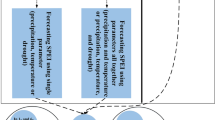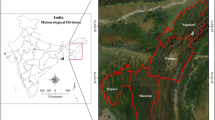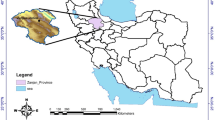Abstract
Changes in precipitation as a result of climate change are becoming a widespread issue all around the world. A lack of rainfall causes a meteorological drought. The short-term Standardized Precipitation Index (SPI-6) index was used to estimate meteorological drought conditions in Saudi Arabia's Asir region from 1970 to 2017. Innovative trend analysis (ITA), the Modified Mann–Kendall test (MMK), the Sequential Mann–Kendall test, and Morlet wavelet transformation were used to detect trend and periodicity in meteorological drought conditions in the Asir region. In addition, the meteorological drought conditions were forecasted by integrating Particle Swarm Optimization (PSO) ensemble machine learning algorithm and an artificial neural network (ANN). Droughts of varying severity have become more frequent in Asir, according to the findings. In most stations, ITA and MMK tests have revealed a significant increase in drought. In all stations, the SQMK test revealed a big sudden year-over-year drought trend. With the exception of one station, all stations experienced extreme drought frequency discovered using Morlet Wavelet Transformation over a long period of time (10 years or more) (station 34). The PSO-ANN hybrid learning algorithm predicted SPI-6 values that had a strong correlation with actual SPI-6 values and also had lower error values, indicating that this model performed well. The PSO-ANN model predicts that the Asir region of Saudi Arabia will experience major moderate to extreme drought events in the coming years (2018–2025). The findings of this analysis will assist planners and policymakers in planning for the acquisition of sustainable agriculture in the study area.







Similar content being viewed by others
References
Abdourahamane ZS, Acar R (2018) Analysis of meteorological drought variability in Niger and its connection with climate indices. Hydrol Sci J 63(8):1203–1218
Abdullah AG, Suranegara GM, Hakim DL (2014) Hybrid PSO-ANN application for improved accuracy of short term load forecasting. WSEAS Transac Power Syst 9(446):51
ACSAD,& ISDR. (2011). Drought vulnerability in the Arab Region: case study—drought in Syria ten years of scarce water (2000–2010). Damascus, Syria: Arab Center for the Studies of Arid Zones and Dry Lands (ACSAD).
Allred BW (1968) Range management training handbook for Saudi Arabia. Food and Agriculture Organization of the United Nations, Rome, p 1968
Almazroui M, Hasanean HM, Al-Khalaf AK, Basset HA (2013) Detecting climate change signals in Saudi Arabia using mean annual surface air temperatures. Theor Appl Climatol 113(3-4):585–598
Al-Taher AA (1994) Drought and human adjustment in Saudi Arabia. GeoJournal 33:411–422. https://doi.org/10.1007/BF00806424
Amin MT, Mahmoud SH, Alazba AA (2016) Observations, projections and impacts of climate change on water resources in Arabian Peninsula: current and future scenarios. Environ Earth Sci 75(10):864
Awchi TA, Kalyana MM (2017) Meteorological drought analysis in northern Iraq using SPI and GIS.Sustainable. Water Resour Manag 3(4):451–463
Baidu M, Amekudzi LK, Aryee JN, Annor T (2017) Assessment of long-term spatio-temporal rainfall variability over Ghana using wavelet analysis. Climate 5(2):30
Bayazit M, Onoz B, Aksoy H (2001) Nonparametric streamflow simulation by wavelet or Fourier analysis.Hydrological. Sci J 46(4):623–634. https://doi.org/10.1080/02626660109492855
Caloiero T (2018) SPI trend analysis of New Zealand applying the ITA technique. Geosciences 8(3):101
Caloiero T (2020) Evaluation of rainfall trends in the South Island of New Zealand through the innovative trend analysis (ITA). Theor Appl Climatol 139:493–504. https://doi.org/10.1007/s00704-019-02988-5
Caloiero T, Coscarelli R, Ferrari E (2019) Assessment of seasonal and annual rainfall trend in Calabria (southern Italy) with the ITA method. J Hydroinf
Chen Y, Guan Y, Shao G, Zhang D (2016) Investigating trends in streamflow and precipitation in Huangfuchuan Basin with wavelet analysis and the Mann-Kendall test. Water 77(8). https://doi.org/10.3390/w8030077
Colak I, Yesilbudak M, Genc N, Bayindir R (2015) Multi-period prediction of solar radiation using ARMA and ARIMA models, 2015 IEEE 14th International Conference on Machine Learning and Applications. Institute of Electrical and Electronics Engineers (IEEE), Miami, pp 1045–1049. https://doi.org/10.1109/ICMLA.2015.33
Czerniak A, Grajewski S, Krysztofiak-Kaniewska A, Kurowska EE, Okoński B, Górna M, Borkowski R (2020) Engineering methods of forest environment protection against meteorological drought in Poland. Forests 11(6):614. https://doi.org/10.3390/f11060614
Demir, V., & Kisi, O. (2016). Comparison of Mann-Kendall and innovative trend method (Şen trend) for monthly total precipitation (Middle Black Sea Region, Turkey).3rd International Balkans Conference on Challenges of Civil Engineering (BCCCE). Tirana, Albania: EpokaUniversit.
Djerbouai S, Souag-Gamane D (2016) Drought forecasting using neural networks, wavelet neural networks, and stochastic models: case of the Algerois Basin in North Algeria. Water Resour Manag 30(7):2445–2464
Eberhart R, Kennedy J (1995) Particle swarm optimization. In: Proceedings of the IEEE international conference on neural networks, vol 4. Citeseer, pp 1942–1948
Fang Y, Qian H, Chen J, &Xu, H. (2018) Characteristics of spatial-temporal evolution of meteorological drought in the Ningxia Hui Autonomous Region of Northwest China. Water 10(8):992. https://doi.org/10.3390/w10080992
Fu Q, Zhou Z, Li T, Liu D, Hou R, Cui S, Yan P (2018) Spatiotemporal characteristics of droughts and floods in northeastern China and their impacts on agriculture. Stoch Env Res Risk A 32(10):2913–2931
Gordan B, Armaghani DJ, Hajihassani M, Monjezi M (2016) Prediction of seismic slope stability through combination of particle swarm optimization and neural network. Eng Comput 32(1):85–97
Hamed KH, Rao AR (1997) A trend test for autocorrelated data. Environmental and Hydrologic Engineering Report CE-EHE-97-7, School of Civil Engineering, Purdue University, West Lafayette
Han P, Wang P, Tian M, Zhang S, Liu J, Zhu D (2012) Application of the ARIMA models in drought forecasting using the standardized precipitation index. In: International Conference on Computer and Computing Technologies in Agriculture, vol 392. Springer, Berlin, pp 352–358. https://doi.org/10.1007/978-3-642-36124-1_42
Hasanean H, Almazroui M (2015) Rainfall: features and variations over Saudi Arabia, a review. Climate 3(3):578–626. https://doi.org/10.3390/cli3030578
Islam ARMT, Talukdar S, Mahato S, Kundu S, Eibek KU, Pham QB, Kuriqi A, Linh NTT (2020) Flood susceptibility modelling using advanced ensemble machine learning models. Geoscience Frontiers
Islam ARMT, Karim MR, Mondol MAH (2021) Appraising trends and forecasting of hydroclimatic variables in the north and northeast regions of Bangladesh. Theor Appl Climatol 143(1):33–50
Jaber HM, Marzuki A (2018) Environmental diversity in Asir Region and its impact on tourism development sustainability. Acad Entrepr J 24(2)
Joshi N, Gupta D, Suryavanshi S, Adamowski J, Madramootoo CA (2016) Analysis of trends and dominant periodicities in drought variables in India: a wavelet transform based approach. Atmos Res 182:200–220. https://doi.org/10.1016/j.atmosres.2016.07.030
Kaushik A, Soni A, Soni R (2015) A hybrid approach for software cost estimation using polynomial neural networks and intuitionistic fuzzy sets. Int J Comput Appl Technol 52(4):292–304. https://doi.org/10.1504/IJCAT.2015.073596
Kendall M (1955) Rank correlation methods, 1st edn. Charles Griffin & Company, ltd., London
Kişi Ö, Santos CA, Silva RM, Zounemat-Kermani M (2018) Trend analysis of monthly streamflows using Şen’s innovative trend method. GEOFIZIKA J 35. https://doi.org/10.15233/gfz.2018.35.3
Kumar S, Chong I (2018) Correlation analysis to identify the effective data in machine learning: prediction of depressive disorder and emotion states. Int J Environ Res Public Health 15(12):2097–2120. https://doi.org/10.3390/ijerph15122907
Labat D, Ababou R, Mangin A (2000) Rainfall–runoff relations for karstic springs. Part II: continuous wavelet and discrete orthogonal multiresolution analyses. J Hydrol 238(3-4):149–178. https://doi.org/10.1016/S0022-1694(00)00322-X
Legates DR, Willmott CJ (1990) Mean seasonal and spatial variability in gauge-corrected, globalprecipitation. Int J Climatol 10:111–127
Li Y, Wen Y, Lai H, Zhao Q (2020) Drought response analysis based on cross wavelet transform and mutual entropy. Alexandria Eng J
Liu X, Zhu X, Zhang Q, Yang T, Pan Y, Sun P (2020) A remote sensing and artificial neural network-based integrated agricultural drought index: index development and applications. Catena 186:104394
Maity R, Suman M, Verma NK (2016) Drought prediction using a wavelet-based approach to model the temporal consequences of different types of droughts. J Hydrol 539:417–428. https://doi.org/10.1016/j.jhydrol.2016.05.042
Mallick J, Singh RK, Khan RA, Singh CK, Kahla NB, Warrag EI, Islam S, Rahman A (2018a) Examining the rainfall–topography relationship using non-stationary modelling technique in semi-arid Aseer region, Saudi Arabia. Arab J Geosci 11(9):1–16
Mallick J, Singh RK, AlAwadh MA, Islam S, Khan RA, Qureshi MN (2018b) GIS-based landslide susceptibility evaluation using fuzzy-AHP multi-criteria decision-making techniques in the Abha Watershed, Saudi Arabia. Environ Earth Sci 77(7):1–25
Mallick J, Bindajam AA, AlQadhi S, Ahmed M, Hang HT, Thanh NV (2020) A comparison of four land surface temperature retrieval method using TERRA-ASTER satellite images in the semi-arid region of Saudi Arabia. Geocarto Int:1–25
Mallick, J., Talukdar, S., Alsubih, M., Ahmed, M., Islam, A.R.M.T., Shahfahad and Thanh, N.V., 2021a. Proposing receiver operating characteristic-based sensitivity analysis with introducing swarm optimized ensemble learning algorithms for groundwater potentiality modelling in Asir region, Saudi Arabia. Geocarto International, pp.1-28.
Mallick J, Talukdar S, Alsubih M, Salam R, Ahmed M, Kahla NB, Shamimuzzaman M (2021) Analysing the trend of rainfall in Asir region of Saudi Arabia using the family of Mann-Kendall tests, innovative trend analysis, and detrended fluctuation analysis. Theor Appl Climatol 143(1):823–841
Mallick J, Alqadhi S, Talukdar S, AlSubih M, Ahmed M, Khan RA, Kahla NB, Abutayeh SM (2021b) Risk assessment of resources exposed to rainfall induced landslide with the development of GIS and RS based ensemble metaheuristic machine learning algorithms. Sustainability 13(2):457
Mann HB (1945) Nonparametric tests against trend. Econometrica 13:245–259 0012-9682(194507)13:3<245:NTAT>2.0.CO;2-U
Mathivha F, Sigauke C, Chikoore H, Odiyo J (2020) Short-term and medium-term drought forecasting using generalized additive models. Sustainability 12(10):4006. https://doi.org/10.3390/su12104006
Mazhar N, Nawaz M, Mirza AI, Khan K (2015) Socio-political impacts of meteorological droughts and their spatial patterns in Pakistan. South Asian Studies 30(1):149
McKee TB, Doesken NJ, Kleist J (1995) Drought monitoring with multiple time scales, 9th Conference on Applied Climatology. American Meteorological Society, Dallas, pp 233–236
Mulinde C, Mwanjalolo M, Twesigomwe E, Egeru A (2016) Meteorological drought occurrence and severity in Uganda. In: Nakileza BR, Bamutaze Y, Mukwaya P (eds) Disasters and climate resilience in Uganda: processes, knowledge and practices. UNDP, Kampala, pp 185–215
Nasri M, Modarres R (2009) Dry spell trend analysis of Isfahan Province, Iran. Int J Climatol 29(10):1430–1438
Ndlovu MS, Demlie M (2020) Assessment of meteorological drought and wet conditions using two drought indices across KwaZulu-Natal Province, South Africa. Atmosphere 11(6):623. https://doi.org/10.3390/atmos11060623
Nguyen H, Moayedi H, Foong LK, Al Najjar HAH, Jusoh WAW, Rashid ASA, Jamali J (2019) Optimizing ANN models with PSO for predicting short building seismic response. In: Engineering with Computers, pp 1–15
Ning Y, Peng Z, Dai Y, Bi D, Wang J (2019) Enhanced particle swarm optimization with multi-swarm and multi-velocity for optimizing highdimensional problems. Appl Intell 49(2):335–351
Omondi OA (2014) Analysis of meteorological drought in north eastern province of Kenya. J Earth Sci Clim Change 5(8):219. https://doi.org/10.4172/2157
Pathak AA, Dodamani BM (2019) Trend analysis of groundwater levels and assessment of regional groundwater drought: Ghataprabha River Basin, India. Nat Resour Res 28(3):631–643
Praveen B, Talukdar S, Mahato S, Mondal J, Sharma P, Islam ARMT, Rahman A (2020) Analyzing trend and forecasting of rainfall changes in India using non-parametrical and machine learning approaches. Sci Rep 10(1):1–21
Procházka P, Hönig V, Maitah M, Pljuˇcarská I, Kleindienst J (2018) Evaluation of water scarcity in selected countries of the middle east. Water 10(10):1482–1500. https://doi.org/10.3390/w10101482
Rahman MR, Lateh H (2016) Meteorological drought in Bangladesh: assessing, analysing and hazard mapping using SPI, GIS and monthly rainfall data. Environ Earth Sci 75(12):1026
Rahman MA, Yunsheng L, Sultana N (2017) Analysis and prediction of rainfall trends over Bangladesh using Mann–Kendall, Spearman’s rho tests and ARIMA model. Meteorol Atmos Phys 129(4):409–424
Raude, J. M., Wambua, R. M., &Mutua, B. M. (2018). Detection of spatial, temporal and trend of meteorological drought using standardized precipitation index (spi) and effective drought index (edi) in the upper Tanariver basin.
Rezaeianzadeh M, Stein A, Cox JP (2016) Drought forecasting using Markov chain model and artificial neural networks. Water Resour Manag 30(7):2245–2259
Rukhaiyar S, Alam MN, Samadhiya NK (2018) A PSO-ANN hybrid model for predicting factor of safety of slope. Int J Geotech Eng 12(6):556–566
Salam R, Islam ARMT, Islam S (2019) Spatiotemporal distribution and prediction of groundwater level linked to ENSO teleconnection indices in the northwestern region of Bangladesh. In: Environment, Development and Sustainability, pp 1–27
Salam, R., Ghose, B., Shill, B.K., Islam, M.A., Islam, A.R.M.T., Sattar, M.A., Alam, G.M.M. and Ahmed, B., 2021. Perceived and actual risks of drought: household and expert views from lower Teesta River Basin of Northern Bangladesh.
Schubert S, Gutzler D, Wang H, Dai A, Delworth T, Deser C, Findell K, Fu R, Higgins W, Hoerling M, Kirtman B (2009) A US CLIVAR project to assess and compare the responses of global climate models to drought-related SST forcing patterns: overview and results. J Clim 22(19):5251–5272
Şen Z (2012) Innovative trend analysis methodology. J Hydrol Eng 17(9):1042–1046. https://doi.org/10.1061/(ASCE)HE.1943-5584.0000556
Seybou AZ, Acar R (2018) Analysis of meteorological drought variability in Niger and its connection with climate indices. Hydrol Sci J 63(8):1203–1218. https://doi.org/10.1080/02626667.2018.1489542
Shamshirband S, Hashemi S, Salimi H, Samadianfard S, Asadi E, Shadkani S et al (2020) Predicting Standardized Streamflow index for hydrological drought using machine learning models.Engineering. Appl Comput Fluid Mechan 14(1):339–350. https://doi.org/10.1080/19942060.2020.1715844
ShangDong, Y., & Xiang, L. (2006). A new ANN optimized by improved PSO algorithm combined with chaos and its application in short-term load forecasting. In 2006 International Conference on Computational Intelligence and Security (Vol. 2, pp. 945-948).IEEE.
Sharma A, Goyal MK (2020) Assessment of drought trend and variability in India using wavelet transform. Hydrol Sci J:1–16
Silva SM, Filho Fd, Júnior LM (2015) Financial mechanism designed with drought indices as a risk management instrument in water resources. Braz J Water Res 20(2):320–330. https://doi.org/10.21168/rbrh.v20n2.p320-330
Sneyers R, Tuomenvirta H, Heino R (1998) Observations Inhomogeneities and Detection of Climate Change The case of the Oulu (Finland) air temperature series. Transport Res Record J Transport Res Board 34(3):159–178
Som AP, Al-Kassem AH (2013) Domestic tourism development in Asir region, Saudi Arabia. J Tour Hosp 02. https://doi.org/10.4172/2167-0269.S5-001
Talukdar S, Pal S (2017) Impact of dam on inundation regime of flood plain wetland of punarbhaba river basin of barind tract of Indo-Bangladesh. Int Soil Water Conserv Res 5(2):109–121
Talukdar S, Pal S (2020) Modeling flood plain wetland transformation in consequences of flow alteration in Punarbhaba river in India and Bangladesh. J Clean Prod 261:120767
Talukdar S, Ghose B, Salam R, Mahato S, Pham QB, Linh NTT, Costache R, Avand M (2020) Flood susceptibility modeling in Teesta River basin, Bangladesh using novel ensembles of bagging algorithms. Stoch Env Res Risk A 34(12):2277–2300
Tarawneh QY, Chowdhury S (2018) Trends of climate change in Saudi Arabia: implications on water resources. Climate 6(1):8–27. https://doi.org/10.3390/cli6010008
Tosunoglu F, Kisi O (2017) Trend analysis of maximum hydrologic drought variables using Mann–Kendall and Şen's innovative trend method. River Res Appl 33(4):597–610
Uddin MJ, Hu J, Islam ARMT, Eibek KU, Nasrin ZM (2020) A comprehensive statistical assessment of drought indices to monitor drought status in Bangladesh. Arab J Geosci 13(9):1–10
Vu-Thanh H, Ngo-Duc T, &Phan-Van, T. (2014) Evolution of meteorological drought characteristics in Vietnam during the 1961–2007 period. Theor Appl Climatol 118:367–375. https://doi.org/10.1007/s00704-013-1073-z
Wang Q, Liu Y, Tong L, Zhou W, Li X, Li J (2018) Rescaled statistics and wavelet analysis on agricultural drought disaster periodic fluctuations in China from 1950 to 2016. Sustainability 10(9):3257. https://doi.org/10.3390/su10093257
Willmott CJ, Matsuura K (2005) Advantages of the mean absolute error (MAE) over the root mean square error (RMSE) in assessing average model performance.Climate. Research 30(1):79–82. https://doi.org/10.3354/cr030079
WMO (World Meteorological Organization) 1982: Methods of correction for systematic error in point precipitation measurement for operational use (B. Sevruk). Operational Hydrology Report No. 21 (WMO-No. 589). Geneva
World Meteorological Organization. 2012. Standardized precipitation index user guide. (M. Svoboda, M. Hayes and D. Wood). WMO-No. 1090. Geneva. ISBN 978-92-63-11091-6. 16p.
Xi W, Li G, Moayedi H, Nguyen H (2019) A particle-based optimization of artificial neural network for earthquake-induced landslide assessment in Ludian county, China. Geomatics, Nat Hazards Risk 10(1):1750–1771
Yilmaz B (2019) Analysis of hydrological drought trends in the GAP region (southeastern Turkey) by Mann–Kendall test and innovative sen method. Appl Ecol Environ Res 17(2):3325–3342. https://doi.org/10.15666/aeer/1702_33253342
Yue S, Wang CY (2004) The Mann–Kendall test modified by effective sample size to detect trend in serially correlated hydrological series. Water Resour Manag 18:201–218. https://doi.org/10.1023/B:WARM.0000043140.61082.60
Yue S, Pilon P, Phinney BOB (2003) Canadian streamflow trend detection: impacts of serial and cross-correlation. Hydrol Sci J 48(1):51–63
Zadeh MR, Amin S, Khalili D, Singh VP (2010) Daily outflow prediction by multi-layer perceptron with logistic sigmoid and tangent sigmoid activation functions. Water ResourManage 24:2673–2688. https://doi.org/10.1007/s11269-009-9573-4
Zehtabian G, Karimi K, Fard SN, Mirdashtvan M, Khosravi H (2013) Comparability analyses of the SPI and RDI meteorological drought indices in South Khorasan province in Iran. Int J Adv Biol Biomed Res 1(9):981–992
Acknowledgements
The authors extend their appreciation to the Deanship of Scientific Research at King Khalid University for proving administrative and financial supports. Authors also would like to thank the Ministry of Environment, Water and Agriculture (MEWA), Saudi Arabia for providing rainfall data for 30 meteorological stations.
Availability of data and material
Data are available upon request.
Code availability
Not applicable.
Funding
Funding for this research was given under award numbers R.G.P2 /92/41 by the Deanship of Scientific Research; King Khalid University, Ministry of Education, Kingdom of Saudi Arabia.
Author information
Authors and Affiliations
Contributions
Conceptualization: Majed Alsubih, Javed Mallick, Swapan Talukdar, and Roquia Salam; data curation: Md. Abdul Fattah; formal analysis: Majed Alsubih, Javed Mallick, Swapan Talukdar, and Roquia Salam; funding acquisition: Majed Alsubih; methodology: Javed Mallick, Swapan Talukdar, Saeed Alqadhi, and Nguyen Viet Thanh; project administration: Majed Alsubih, Saeed Alqadhi, and Javed Mallick; resources: Saeed Alqadhi, Majed Alsubih, and Nguyen Viet Thanh; software: Javed Mallick and Swapan Talukdar; supervision: Majed Alsubih and Javed Mallick; validation: Swapan Talukdar and Javed Mallick; writing—original draft: Javed Mallick, Swapan Talukdar, and Saeed Alqadhi; writing—review and editing: Javed Mallick and Roquia Salam.
Corresponding author
Ethics declarations
Ethics approval
We confirm that this article is an original research and has not been published or presented previously in any journal or conference in any language.
Consent to participate
Not applicable.
Consent for publication
All the authors consented to publish the paper.
Conflict of interest
The authors declare no conflict of interest.
Additional information
Publisher’s note
Springer Nature remains neutral with regard to jurisdictional claims in published maps and institutional affiliations.
Supplementary Information
ESM 1
(DOCX 25284 kb)
Rights and permissions
About this article
Cite this article
Alsubih, M., Mallick, J., Talukdar, S. et al. An investigation of the short-term meteorological drought variability over Asir Region of Saudi Arabia. Theor Appl Climatol 145, 597–617 (2021). https://doi.org/10.1007/s00704-021-03647-4
Received:
Accepted:
Published:
Issue Date:
DOI: https://doi.org/10.1007/s00704-021-03647-4




